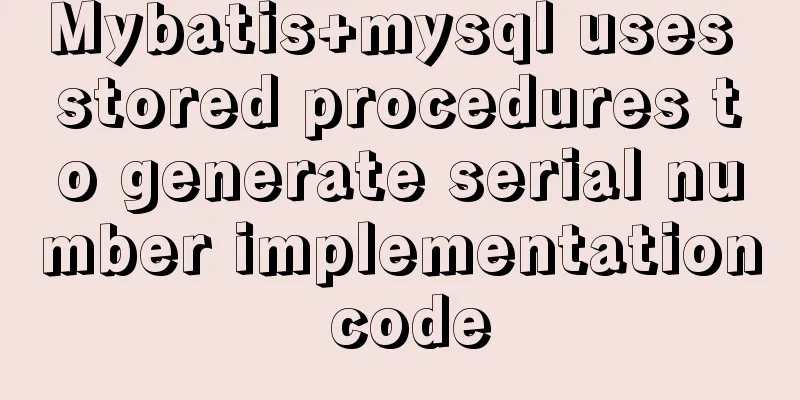Mybatis+mysql uses stored procedures to generate serial number implementation code

|
Use stored procedures to start transactions when operating the database to avoid data duplication caused by concurrent operations
CREATE DEFINER=`root`@`localhost` PROCEDURE `GetSerialNo`(IN tsCode VARCHAR(50),OUT result VARCHAR(200) )
BEGIN
DECLARE tsValue VARCHAR(50);
DECLARE tdToday VARCHAR(20);
DECLARE nowdate VARCHAR(20);
DECLARE tsQZ VARCHAR(50);
DECLARE t_error INTEGER DEFAULT 0;
DECLARE CONTINUE HANDLER FOR SQLEXCEPTION SET t_error=1;
START TRANSACTION;
/* UPDATE sys_sno SET sValue=sValue WHERE sCode=tsCode; */
SELECT sValue INTO tsValue FROM sys_sno WHERE sCode=tsCode;
SELECT sQz INTO tsQZ FROM sys_sno WHERE sCode=tsCode;
-- There is no record in the factor table, insert the initial value IF tsValue IS NULL THEN
SELECT CONCAT(DATE_FORMAT(NOW(),'%y%m'),'0001') INTO tsValue;
UPDATE sys_sno SET sValue=tsValue WHERE sCode=tsCode;
SELECT CONCAT(tsQZ,tsValue) INTO result;
ELSE
SELECT SUBSTRING(tsValue,1,4) INTO tdToday;
SELECT CONVERT(DATE_FORMAT(NOW(),'%y%m'),SIGNED) INTO nowdate;
-- Determine whether the year and month need to be updated IF tdToday = nowdate THEN
SET tsValue=CONVERT(tsValue,SIGNED) + 1;
ELSE
SELECT CONCAT(DATE_FORMAT(NOW(),'%y%m') ,'0001') INTO tsValue;
END IF;
UPDATE sys_sno SET sValue = tsValue WHERE sCode = tsCode;
SELECT CONCAT(tsQZ,tsValue) INTO result;
END IF;
IF t_error =1 THEN
ROLLBACK;
SET result = 'Error';
ELSE
COMMIT;
END IF;
SELECT result ;
END;
dao
Integer getFaultNo(Map<String, String> parameterMap);xml
<update id="getFaultNo" parameterMap="getFaultMap" statementType="CALLABLE">
CALL GetSerialNo(?,?)
</update>
<!--
parameterMap.put("tsCode", 0);
parameterMap.put("result", -1);
-->
<parameterMap type="java.util.Map" id="getFaultMap">
<parameter property="tsCode" mode="IN" jdbcType="VARCHAR"/>
<parameter property="result" mode="OUT" jdbcType="VARCHAR"/>
</parameterMap>Call
Map<String, String> parameterMap = new HashMap<String, String>();
parameterMap.put("tsCode", "a");
parameterMap.put("result", "-1");
faultMapper.getFaultNo(parameterMap);
// insert failure log (main table)
if (!parameterMap.get("result").equals("-1") &&
!parameterMap.get("result").equals("Error")) {
//Success} else {
throw new RuntimeException();
}Summarize The above is the implementation code of mybatis+mysql using stored procedures to generate serial numbers introduced by the editor. I hope it will be helpful to everyone. If you have any questions, please leave me a message and the editor will reply to you in time. I would also like to thank everyone for their support of the 123WORDPRESS.COM website! You may also be interested in:
|
<<: Summary of Linux user groups and permissions
>>: Steps to introduce PWA into Vue project
Recommend
JavaScript canvas to load pictures
This article shares the specific code of JavaScri...
Instructions for using the --rm option of docker run
When the Docker container exits, the file system ...
MySQL trigger principle and usage example analysis
This article uses examples to explain the princip...
Vue Element UI custom description list component
This article example shares the specific code of ...
Detailed explanation of the spacing problem between img tags
IMG tag basic analysis In HTML5, the img tag has ...
5 solutions to CSS box collapse
First, what is box collapse? Elements that should...
JavaScript Basics: Scope
Table of contents Scope Global Scope Function Sco...
MySQL binlog opening steps
Binlog is a binary log file that is used to recor...
In-depth understanding of CSS @font-face performance optimization
This article mainly introduces common strategies ...
How to install MySQL using yum on Centos7 and achieve remote connection
Centos7 uses yum to install MySQL and how to achi...
Understanding and solutions of 1px line in mobile development
Reasons why the 1px line becomes thicker When wor...
How to install kibana tokenizer inside docker container
step: 1. Create a new docker-compose.yml file in ...
Detailed explanation of Nginx timed log cutting
Preface By default, Nginx logs are written to a f...
Detailed explanation of several clever applications of position:sticky sticky positioning
Background: position: sticky is also called stick...
Detailed analysis of GUID display issues in Mongodb
Find the problem I recently migrated the storage ...










